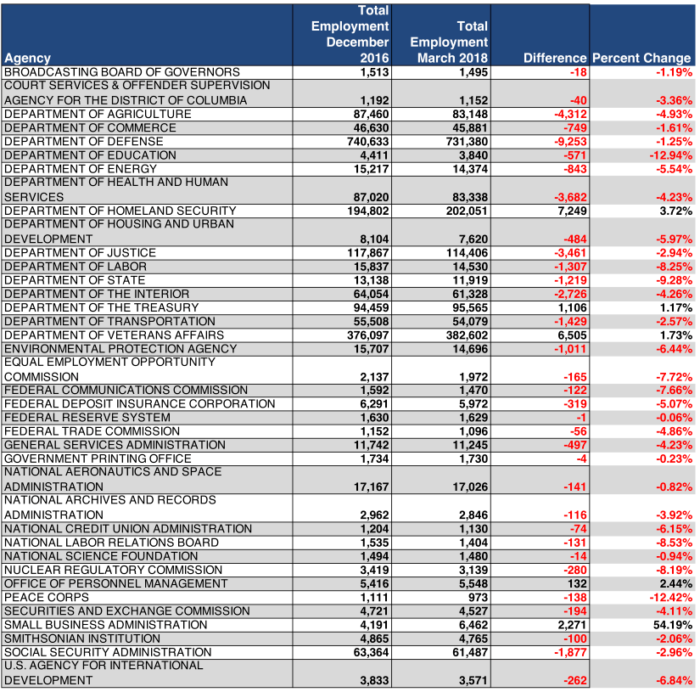
The shrinking federal workforce
Are agencies hiring at levels consistent with their budgets and past hiring practices? Former DHS CHCO Jeff Neal looks at OPM's employment numbers.
This column was originally published on Jeff Neal’s blog, ChiefHRO.com, and was republished here with permission from the author.
My most recent post discussed the idea that agencies may under-obligate their funds in fiscal 2018, leading to reduced spending and loss of budget authority. One way that can manifest itself is in reduced hiring. Although the Impoundment Act requires agencies to spend the money that Congress appropriates, there is not an effective enforcement mechanism. That is particularly true with respect to staffing levels.
Following my last post, I got questions regarding hiring numbers. Folks wanted to know if agencies are hiring at levels consistent with their budgets and past hiring practices. I thought that was a great question, so I decided to look at total employment numbers from December 2016 and compare them with the most recent public data from OPM”s Fedscope tool.
What I found was that federal employment has dropped significantly. The table below shows the total number of employees for the cabinet-level and large (1,000 or more employees) agencies. Total employment in those agencies is down about one percent, but that number varies widely from one agency to another. Among Cabinet-level agencies, the Department of State is down 9.28 percent, Education is down 12.94 percent, Labor is down 8.25 percent, and Housing and Urban Development is down 5.97 percent. Homeland Security is up 3.72 percent (mostly disaster recovery workers in the Federal Emergency Management Agency) and Veterans Affairs is up 1.73 percent. The Small Business Administration is up by 54 percent, also due to temporary employees required for disaster recovery work

These numbers do not take into account the variations caused by seasonal hiring, but the agencies that have the biggest drops are not the larger users of seasonal hires. If we did not have the surge in hiring related to disaster recovery, the decrease in total employment would be even greater. The bottom line is that federal employment numbers are dropping and in some agencies they are dropping significantly. For the first two quarters of the fiscal year, agencies chose to hire fewer new employees. Because the final appropriations deal was not completed until mid-year, and the administration had proposed significant reduction in some agencies, one could plausibly argue that agencies were simply adhering to the president’s budget. Now that we have real numbers, agencies should be hiring more people (and awarding more contracts). Whether that happens, or they choose to continue hiring at reduced levels, is not likely to be known until it is too late to do anything to change it.
Even if Congress wants to address the issue, there is little they can do to drive hiring and contract spending. The most likely mechanism would be floors on employment numbers (either in terms of employees or salary dollars) and similar requirements for contract dollars that must be spent. The likelihood of getting something like that passed is somewhere close to zero and it would be almost impossible to enforce. As I have said before, the executive branch gets to execute. If it wants to reduce spending, as long as it does not step on too many toes of the right people in Congress, it can do it.
Jeff Neal is a senior vice president for ICF and founder of the blog, ChiefHRO.com. Before coming to ICF, Neal was the chief human capital officer at the Homeland Security Department and the chief human resources officer at the Defense Logistics Agency.
Copyright © 2024 Federal News Network. All rights reserved. This website is not intended for users located within the European Economic Area.




